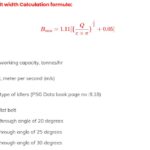Conveyor motor selection calculations
In the last article: Conveyor belt width calculation formula | Conveyor Design Part 1 We understood the basic components and assumptions of conveyor design. In this article, we will learn how to do conveyor motor selection calculations. Basically, we are focusing on belt conveyor motor selection calculations.
Type of motors are used in conveyor systems?
There are various types of motors used in daily household and industrial applications. For the flat belt conveyor system that runs continuously in a single direction, the first choice is an AC induction motor.
Motor power calculations for the conveyor
To calculate the motor power required for the conveyor, Firstly, we need to calculate the net pull acting on the belt. We can calculate the net belt pull by calculating the resistance of the belt for the upper run (Wo) and the resistance of the belt for the lower run (Wu).
Resistance of the belt for the upper run
$$Wu\;=\;CfL\lbrack(G_g+G_b)cos\delta+G_o\rfloor\pm H(G_g+G_b)$$ ………. (eq. 1)
Resistance of the belt for the lower run
$$Wl\;=\;CfL\lbrack G_bcos\delta+G_o\rfloor\pm HG_b$$ ………. (eq. 2)
Where,
C = adjustment factor for secondary resistance
f = friction factor between idler or skid plate and belt
Usually, the friction factor is 0.005 to 0.5.
For standard conveyors, – 0.02
For non-portables with good idlers, -0.016 to 0.018 (PSG design data 9.17)
And 0.023 to 0.027 for idlers in a dusty environment (PSG design data 9.17).
L = material conveying distance
Gg = weight of the material conveying per metre of length (kg/metre)
Gb = weight of the belt per metre of length (kg/metre)
Go = weight of troughing idlers on the top run/metre length
δ = angle of inclination of the conveyor
H is the height through which material is conveyed.
Calculation formula for the adjustment factor for surface resistance
$$C=\;\frac{17.\ln\left(L\right)}L+1$$ ……………. (eq. 3)
Where,
C = adjustment factor
L = conveying distance in metres
Ln = natural logarithm = log to the base e
Calculation formula for weight of the material conveying per metre length
$$G_g=\frac Q{3.6\;*\;v}$$ ……………. (eq. 4)
Where,
Gg = weight of the material conveying per metre length
Q = conveyor working capacity TPH
V = belt speed, metre per second (m/s)
Calculation formula for height through which material is conveyed
$$H\;=\;L\;*\;\sin\delta$$ ………………. (eq. 5)
Now, we can calculate the effective belt pull from equations 1 and 2.
$$F\;=\;W_u+W_l\;$$ ………………….………. (eq. 6)
Calculation formula for required motor power.
Pm = Belt pull X Linear velocity of the conveyor X Adhesion factor between roller and belt
$$P_{motor}=\frac{F\;*\;v\;*\;1.2}{Transmissions\;efficiency}\;X\;factor\;of\;safety$$ ……… (eq. 7)
Also,
We can calculate motor power by using belt pull, belt speed and drive pulley diameter.
$$Torque=Belt\;pull\;\ast\;Radius\;of\;drive\;pulley$$
$$Torque=Fpull\;\ast\;r\;\;\;\;\;\;\;\;\;\;\;\;\;\;in\;N.m$$…………..(eq.8)
$$P_{motor}=Torque\;\ast\;Angular\;velocity$$
$$P_{motor}=T\;\ast\;\omega\;\;\;\;\;\;\;\;\;\;\;\;\;\;\;\;\;\;Watt$$………..(eq.9)
As stated in the problem statement in the conveyor belt width calculation formula (Conveyor Design Part 1),
So, we have to design for
-
-
- Conveyor working capacity: 45 TPH
- Angle of Inclination from Horizontal: 0 Degree
- Centre distance: 4000 mm
-
General assumptions:
-
-
- Drive and driven pulleys are the same.
- single pulley-driven system.
- The angle of the wrap is approximately 180 degrees.
-
By substituting values in eq.1 to eq.7 determine the values for the following,
- Weight of the material conveying per metre length
- Adjustment factor
- Resistance of the belt for the upper run
- Resistance of the belt for the lower run
- Net effective belt pull
1. weight of the material conveying per metre length
Substitute values in eq no.4 and taking a velocity of 1.3 metres per second (refer to the calculations in Part 1)
$$G_g=\frac Q{3.6\;*\;v}$$
$$=\frac{45}{3.6\;*\;1.3}$$
$$Gg=9.61\;kg/meter$$
2. Adjustment factor for surface resistance
Substitute values in eq no.2
$$C=\;\frac{17.\ln\left(L\right)}L+1$$
$$C=\;\frac{17.\ln\left(4\right)}4+1$$
$$=\;6.891$$
Weight of belt for 400 mm width Gb = 5 kg/metre (as per PSG design data book page no. 19)
H = 0 due to the angle of inclination of 0.
3. Resistance of the belt for the upper run
$$Wu\;=\;CfL\lbrack(G_g+G_b)cos\delta+G_o\rfloor\pm H(G_g+G_b)$$
$$=6.891*0.02*4\left\lfloor\left(9.61+5\right)cos0+0\right\rfloor\\=8.05\;kg$$
Similarly,
4. Resistance of the belt for the lower run
$$Wl\;=\;CfL\lbrack(G_b)cos\delta+G_o\rfloor\pm H(G_b)$$
$$Wl=6.891X0.02X4\left\lfloor5cos0+0\right\rfloor$$
$$Wl=2.7564\;kg$$
5. Net effective pull on belt is,
$$F{pull}\;=\;W_u+W_l$$
= 8.02 + 2.7564
= 10.8064 kg
Fpull= 10.8064 x 9.81 (Acceleration due to gravity 9.81 m/s^2)
Fpull= 106.01 N
6. The required motor power for the belt conveyor is
$$P_{motor}=\frac{F\;*\;v\;*\;1.2}{Transmissions\;efficiency}\;X\;factor\;of\;safety$$
$$P_{motor}=\frac{101.6\;\ast\;1.3\;\ast\;1.2}{0.9}\;X\;2$$
= 352.2 Watt
Pm= 0.352 Kw
Pm= 0.478 hp ~ 0.5 hp (as we know 1 hp = 746 Watt)
Most of the 3-phase induction motors come in the sizes of 0.25 hp, 0.5 hp, 0.75 hp, 1 hp 1.5 hp and so on. We will select 3 phase 0.5 hp motor initially.
But, while selecting motor we have to consider some more points as well,
-
-
-
- Application type ( continuous work or intermittent work )
- Starting torque
- Operating voltage
- Operating frequency
- Working environment temperature
- No of poles and speed
-
-
We will learn how to select motor with above points in conveyor design part 3.
Online calculator for motor selection calculations

